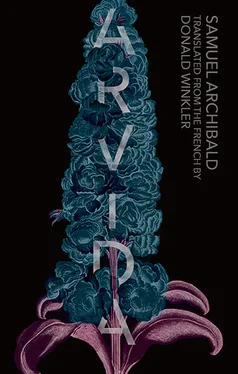Not a big deal, anyway. The second thing I came on later, when I had to open up the attic on the third floor. I hadn’t inspected it the first time through because I didn’t even know there was a room there. I thought it was just lost space under the roof, but the architect I hired to redo the house found the original plans in the municipal archives. He said there was a room up there. His idea was to renovate the master bedroom upstairs by opening up the floor above it to add height, and gain access to the skylight he saw in the plan. Before starting his design he wanted me to confirm its existence.
In a second-floor room, in the corner, there were two doors that you could easily mistake for cupboards. The second was one in fact, but the first opened onto a small staircase. At the top there was a solid oak door with a large lock on the outside. The key to open it was not on the key ring the Villeneuve son had given me. Nor anywhere else. I got out my chainsaw once more. It was too bad because it was a handsome door, but it was going to disappear in any case, given the architect’s plan. I was careful not to fall backwards into the stairway, and I cut a big square out of the door around the lock, which fell to the floor, so all I had to do was push.
The room was just barely illuminated by the light from the opening in the roof. It was humid and musty. It also seemed to smell of pee. The floor was of barnwood, not maple, like in the rest of the house. There were two beds: a small single bed with drawers underneath, almost child size, and a Health Management Systems hospital bed with wooden uprights. There was also a chest of drawers with a little television on top, a wardrobe at the back, and on the right wall the opening for a dumbwaiter that communicated with the kitchen. On the descending walls of the dormered roof, there were posters: Judas Priest, Iron Maiden, and three ladies, boobs in the air. Even where it peaked, in the middle, the room was suffocating. Your instinct was to bend your neck so as not to bump the ceiling, which couldn’t have been more than seven feet at its highest point. In the middle of the room, between the two beds, there was a wheelchair.
I couldn’t understand their putting a handicapped person’s room in such an out-of-the-way corner of the house, where it couldn’t have been an easy matter to enter and leave. It was as if the furniture was walled up in there, as well. I had to take the two beds apart to get them out.
The armchair, the cupboard, and the chest of drawers just barely squeaked through. I kept the wardrobe, a lovely cherry wood piece, to refinish it, and all the rest I threw out. Except for the wheelchair, which I brought down to the basement, I don’t know why.
Hardly anyone believes me, but under the standard bed someone had carved a symbol like this, with a knife, in the wooden floor:

I didn’t want to start in with Villeneuve Junior or Madame in her old folks’ home, so instead I went to see Armand Sénécal.
I hadn’t seen him for ages, and I’d been told that he was going all over town telling everyone he wasn’t overjoyed that I was the one who’d bought the Villeneuve house. He felt he’d been had. That’s not exactly the word he used, but never mind. I went to see him in his office downtown, we chewed each other out over it for a while, then I told him I hadn’t paid much more for the house than I’d advised him to put into it, and that I had a good ten years ahead of me to renovate it, just like I’d said. I was prepared to do it, he wasn’t, and nobody had screwed anyone. He said, “Okay, you’re right,” and then he asked me what I was doing there. I told him about the room in the attic, and then I asked him if he knew what the story was.
Senecal said:
“When Médéric Villeneuve handed down his house, it was on one condition. Whoever inherited it had to keep on there the two youngest sons in the family. The room at the top was set up for them, they were there during vacations, and then all year round when Médéric moved into the house permanently. There was about three years between them. Vallaire, the older one, was not handicapped, he was just weak in the head. Thibeau, the younger, had Andermann Syndrome. The Charlevoix sickness. After he was twelve or thirteen years old, he could no longer walk. His spine was all twisted with scoliosis, and he had epileptic seizures to boot. From what I heard, he was slow in some ways, for sure, but overall he was a bit more with it than his brother. It’s Viateur who took them on, and it’s Viateur who got the house. He paid a nurse to take care of them, but I think his wife and children helped out a lot, given that the inheritance was dwindling away. At the end, the nurse came only during the day, when they weren’t there. It was a big burden for a small family. Was there ever anything like that in yours?”
“No. What happened to the brothers? They ended up being placed, I imagine?”
“They’re dead.”
He seemed ill at ease. He must have seen the expression on my face, not at all happy with the news, because he went on:
“Not in your house. But not far away either, I have to say. Do you really not remember the story? It was in 1982, or maybe ’83.”
“I was working in Montreal then.”
“Yes, that’s right. Okay. One night when Viateur, his wife, and his children had gone off I don’t know where, and the nurse had left as well, the eldest took his little brother in his arms, and carried him down to the main floor. He put him in his wheelchair, pushed him outside, and down along the path that led to the old rock quarry. There was a place where the path turned sharply to the left because in front there was a drop of about a hundred feet leading to a cliff and then to the lake of rainwater that had built up at the bottom of the quarry. Once there, Villaire raised up the chair as though to unload a wheelbarrow, and tipped his brother over the edge. Vallaire then threw himself after him. When the adults got back they found the wheelchair sitting there, and the police retrieved the two brothers from the waterhole the following week. That wasn’t a sheer cliff. Their bodies had been torn apart on the rocks as they tumbled down. It seems that they were so mangled when they came out of the water that each body had to be pieced together in order to determine which one was the cripple.”
A chill ran down my back. I told myself that I had absolutely to check out that path before Julie hurt herself, playing outside.
“The worst thing about the story is that when you think about it a little, you can understand. Mario Leroux, the guy from the provincial police, talked to me about it one night when we were having a beer at the Le Stade sports bar. He said, ‘You know, in that business, there were two problems. Vallaire Villeneuve didn’t have all his marbles, but he wasn’t crazy enough to do something like that. Thibeau wasn’t exactly an Olympic champion, but he wasn’t so paralyzed as to have that done to him without at least trying to throw himself to the ground, or something. We didn’t tell the papers what we really thought, because we didn’t want to hurt anybody. Our conclusion was based on the fact that people with Andermann Syndrome tend to go psychotic. If you ask me, it’s Thibeau, who couldn’t walk, who convinced his big brother to perform the act. Can you imagine?’”
I could imagine very well. I thanked Armand for the fascinating story, and above all for not having told it to me before. I went home, I pulled the wheelchair out of the basement, and took it right to the dump. The following Sunday I drove to Potvin & Bouchard, to the lumberyard. Back home, I was able to find the old path without clearing it out, I made my way down to the drop-off, I tried not to look at the waterhole staring back at me like a cadaver’s eye, and I spent all day building a barrier that’s still there, intact.
Читать дальше













